Your Guide to Cooking A Turkey
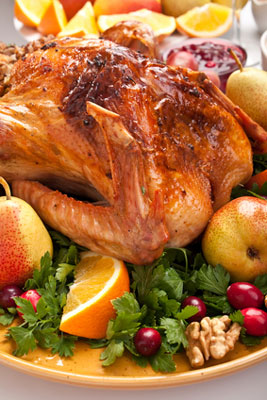
There is no need to limit turkey simply to the holiday period. Turkey can be cooked in so many ways, from burgers, soup, casseroles and meatloaf. But of course the most popular method by far is roasting.
Many people baulk at the prospect of roasting a turkey, but cooking a turkey is no more difficult than cooking a chicken, just larger.
However, keeping it healthy depends on how it is cooked. Cooking in fat or smothering it with rich, creamy sauces means it is no longer healthy.
Once you know how to select the best turkey, you then need to know how to safely prepare it, and this includes storing, thawing and whether to stuff or not.
Buying Your Turkey
Buying a turkey is confusing with all the options available. Do you know what the labels mean?
Fresh
Fresh means the turkey has never been chilled below -3°C / 26°F, the temperature at which turkey meat freezes.
Frozen
A frozen turkey has been chilled below -17°C / 0°F. If it has been chilled and defrosted, then it should be labelled “previously frozen”.
Note: Turkeys that have been chilled below -3°C / 26°F and above -17°C / 0°F can’t be labelled fresh. But they are not strictly frozen either. If a turkey isn’t labelled as either fresh or frozen then it’s most likely in this category.
Free Range
Free range means the bird has not been raised in a cage and has roamed freely grazing on grasses or grains.
Organic
A turkey carrying the “organic” label must be raised free-range, without the use of antibiotics, and fed an organic and vegetarian diet free from pesticides.
Natural
The word “natural” can mean that the bird is antibiotic-free, free-range and/or raised on a vegetarian diet, but you really need to check the labels to confirm this. Some birds carrying the “natural” label claim to be “hormone-free”. But in fact all poultry products sold with the USDA seal are hormone-free.
Kosher
Birds carrying the “kosher” label have been farmed and slaughtered according to Jewish dietary traditions. The birds are free-ranging and grain fed with no antibiotics. But they also undergo a salting process, which means they are unsuitable for brining.
Conventional
This is the standard turkey found in the supermarkets. Often factory-farmed with the use of antibiotics, they are bred to have a plumper, broader breast.
Self-Basting
As the name suggests, these turkeys have been injected with a solution of fat and broth or water, salt and sometimes herbs, spices and preservatives to eliminate basting during the cooking process. Not suitable for brining.
Heritage
Heritage turkeys are raised naturally, free from chemicals and antibiotics. These birds look and taste quite different to their modern counterparts which are artificially bred to contain more white meat.
Bred from breeds that can trace their ancestry back hundreds of years, heritage turkeys have a white to dark meat ratio closer to 50/50 with a much slower rate of growth. But they are expensive at more than double the price of a supermarket bird. Their great advantage is their flavour with a much greater proportion of dark meat.
What Size Turkey to Buy?
As a general guide, allow at least one pound of meat per person. For larger birds, you can allow a bit less as there’s more meat in proportion to bone.
How to Store
Unless you intend cooking your turkey straight away, it will need to be safely stored.
Storing Fresh
Fresh turkey can be kept in the refrigerator but should be used within 2 - 3 days of purchase.
Storing Frozen
A whole frozen turkey can be safely stored in the freezer for 1 year, parts for 6 months. Ground meat can be frozen for 2 - 3 months.
Once thawed it needs to be kept refrigerated and cooked as soon as possible.
Storing after Cooking
It’s possible you will have leftovers. Personally I love cold cooked turkey. It’s delicious in salads, sandwiches and wraps. You can also add it to soups, stews and casseroles, frittatas, pasta and rice dishes.
Cooked turkey will keep in the fridge for up to 3 days. Store in a suitable covered container.
Cooked turkey can also be frozen for up to 3 months. Remove the skin first, then tightly pack the meat into freezer bags, expelling as much air as possible.
NOTE:
After cooking your turkey, keep it hot (above 140°F / 60°C) or refrigerate (below 40°F / 4°C). Never leave a cooked bird at room temperature for longer than 2 hours.
Turkey Know How
How to Prepare a Turkey
Okay you’ve purchased your turkey, brought it home and defrosted it – what now?
Take the turkey from the fridge thirty minutes to an hour before roasting and remove any wrapping.
Place your hand inside the cavity and remove the giblets. (This is the bag that contains the neck, liver and various other parts of the turkey). Unless you intend using this to make gravy, throw it away.
Wipe the bird inside and out with damp paper towel.
Place the turkey on a roasting rack set inside a roasting pan and leave to sit.
To Stuff or Not to Stuff?
I believe it is safer not to stuff your turkey. The internal temperature of the stuffing much reach 75°C / 165°F to kill off any bacteria. As the stuffing is deep inside the turkey getting it up to that temperature means you risk overcooking your bird and ending up with dry meat. Stuffing cooked separately can be just as delicious and is much safer.
How to Cook a Turkey
Heat your oven to 230°C / 450°F. If you haven’t brined your turkey, rub with salt and pepper.
Add two cups of water or stock to the roasting pan.
Place the pan containing the turkey in the bottom part of the oven and reduce the heat to 180°C / 350°F.
Keep basting every 45 minutes. Remove the turkey from the oven, tilt the pan and using a turkey baster or spoon, ladle up the pan liquids and drizzle them over the top. Basting your turkey helps the meat to cook more evenly. Basting with oil or butter during the last 45 minutes of cooking crisps the skin and turns it a beautiful deep golden brown.
If you find your bird is cooking too quickly, cover the top with aluminium foil.
How long you cook your turkey will depend on size, but the rule of thumb is 13 minutes per pound. And remember, an un-trussed, unstuffed bird will cook much faster.
Remember also oven temperatures vary so always check for doneness before removing from the oven. Insert a meat thermometer into the thickest part of the thigh (without touching the bone). It should register 75°C / 165°F. If not return to the oven, cover with foil, and continue cooking for another 20 minutes.
Once cooked remove from the oven, place the turkey on a tray, cover with foil and leave to rest for at least 30 minutes. This allows the meat to firm up and the juices to distribute evenly resulting in tender juicy meat.
Cooking Times
Approximate Timetable for Cooking a Turkey Roast at 325°F (160°C)
| Weight | Stuffed Time in Hours |
Unstuffed Time in Hours |
| 6 - 8 lbs (3.0 - 3.5 kg) |
3 - 3 ¼ | 2 ½ - 2 ¾ |
| 8 - 10 lbs (3.5 - 4.5 kg) |
3 ¼ - 3 ½ | 2 ¾ - 3 |
| 10 - 12 lbs (4.5 - 5.5 kg) |
3 ½ - 3 ¾ | 3 - 3 ¼ |
| 12 - 16 lbs (5.5 - 7.0 kg) |
3 ¾ - 4 | 3 ¼ - 3 ½ |
| 16 - 20 lbs (7.0 - 9.0 kg) |
4 ¼ - 4 ¾ | 3 ¾ - 4 ½ |
| 20 - 24 lbs (9.0 - 10.9 kg) |
4 ¾ - 5 ½ | 4 - 5 |
Tasty Turkey Recipes
Home » Cooking a Turkey
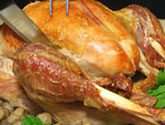
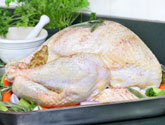
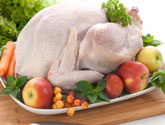
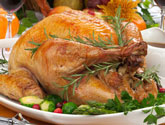
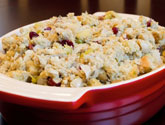
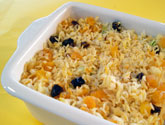


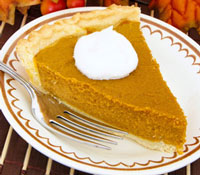
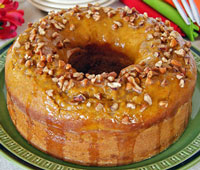
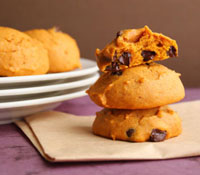

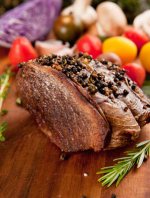
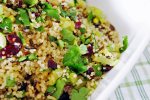
New! Comments
Have your say about what you just read! Leave me a comment in the box below.